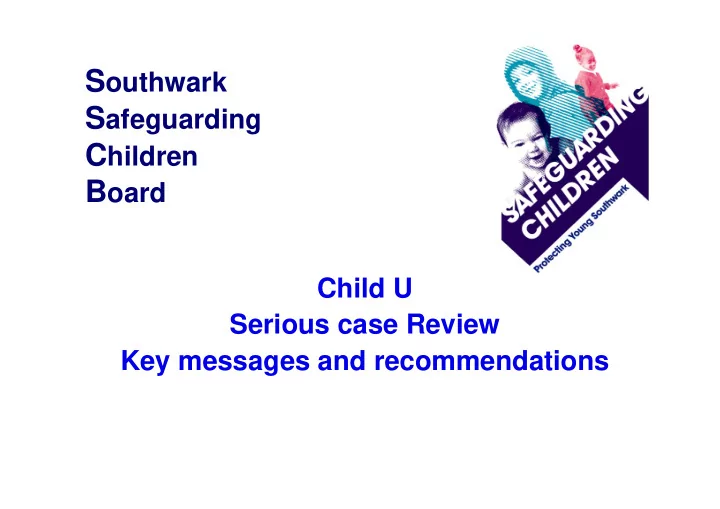

S outhwark S afeguarding C hildren B oard Child U Serious case Review Key messages and recommendations
Decision to hold a SCR ‘ there is cause for concern as to the way in which the authority, their board partners or other persons have worked together to safeguard the child ’ Welsh Model ‘….an emphasis on promoting a positive culture of multi-agency child protection learning and reviewing in local areas..’
Who is Child U? • 16 year old boy of black African origin • Born in UK both parents from Sierra Leone • Brother 4 years older, sister 4 years younger • Killed in a knife attack in SE17 on 14 September 2015 • Police later arrested a suspect and case was due to go to trial but this was discontinued on the advice of the CPS
Family background A childhood in both England and Sierra Leone • went to Sierra Leone at 3 yrs old (2002) attending a private school • Mother gave birth to daughter whilst U was in Sierra Leone • returned to UK aged 10 years (2009) • started secondary 4 years behind expected level (2010) • ‘Nurture Group’ approach until start year 10 (Sept 2013) Family Issues • Mother was concerned about risks from drugs, violence and gang culture in the area • brother as a child had serious behavioural difficulties • brother assessed by Children’s Social Care in 2010 • siblings were not assessed at time • brother was briefly accommodated in 2010.
The review period February 2014 to September 2015 • February 2014 U’s brother was serving a 30 month prison sentence for robbery with a knife • U excluded 4 times from school for disruptive behaviour and offered pastoral support and mentoring services • March 2014 U had a ‘managed move’ between secondary schools for a ‘fresh start’. • April 2014, two presentations to St Thomas’ Hospital for facial injury & knee injury. • September 2014 onwards U returned to school with ‘a recognisably changed attitude’. • U truanted, challenging and disruptive in school
The review period February 2014 to September 2015 • Autmn term 2014 U started going missing frequently and coming to the notice of police • U explained to his mother in a letter (found after his death) that he was staying away from home as he was afraid of one particular young man. • Jan 2015 moved from school to a work based programme ‘Building Lives’ that lasted one term • April 2015 assaulted another pupil and was asked to leave and returned for mainstream secondary for final term
The review period February 2014 to September 2015 • February 2015 U’s brother released from prison and stabbed the same day • April 2015 U’s brother stabbed a second time. Returned to prison due to possession of blade and baseball bat • June 2015 U arrested in connection with an armed robbery of a pizza delivery man and fleeing scene was said to discard ‘a long bayonet type hunting knife.’ He was bailed to appear at court on 23/9/15. • July 2015 U went missing for 12 days. On his return home interview stated he had been with friends • 14 September 2015 U was stabbed and killed
Findings from the SCR Education • Little knowledge of U’s experience of education or care in Sierra Leone between 3-10 years • Low achiever and unable to access mainstream curriculum • struggled with communication due to poor English • a lot of work to avoid permanent exclusion and keep pupils safe and secure 8
Findings from the SCR Statutory services • Many missing episodes and poor school attendance that did not trigger education welfare services • Not involved with YOS, met threshold for preventative work • CSC assessment of brother didn’t focus on siblings, U never referred to CSC • Agencies involved generally carried out their roles well but never worked as a whole • information sharing 9
SCR conclusion What happened in this case? ‘Generally agencies worked in ‘silo’s’ possibly not knowing how and when to share information in an effective way…..The cumulative effect was that, as U’s behaviour deteriorated at school and at home….there was no single professional who was in a position to assess how all this fitted together.’ SCR authors 10
How do the risk of a young man like U begin to be known about? How do we link emerging elements such as • Drug use • Going missing/offending • Gang associations • Attraction to carrying knives ..with a young person who has • Low school achievement • English as a second language • A history of separation and loss • A violent older male sibling • A previous history of living in a war-torn country 11
‘As a Review Panel, we do not believe that there was anything that agencies could have done to predict the tragic outcome for U, nor, sadly, to prevent this happening’ 12
Recommendations include: Schools and education support services • Consistent assessment of children’s needs • From abroad • Between schools including secondary transition • Role of Safer Schools officers • Risk management and work with other agencies around exclusion and violence 13
Recommendations include Children’s Social care • Assessments better capture child’s psycho- social history, experience of care by other relatives, and siblings SSCB • Improving partnership wide understanding of thresholds • Local strategy for preventing and reducing knife crime and violence – both for young people at risk of / causing violence to others 14
16 BREAK
In context of recommendations 1. How can we build better working relationships between schools, statutory services and police to support other young people in a similar situation? 2. How can we meaningfully use threshold guidance to support practice? 3. How can we work with the community to tackle knife crime and its associated issues? 17
Recommend
More recommend